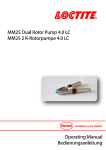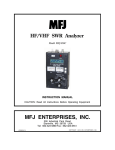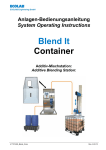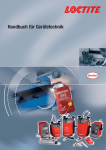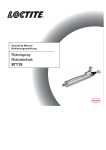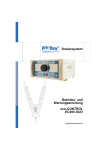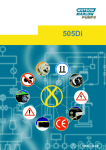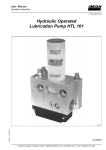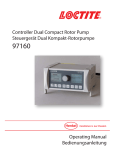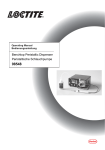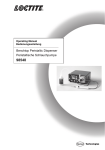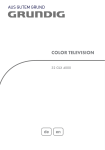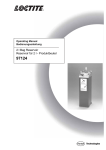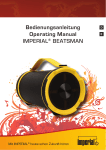Download 4 Installieren - LOCTITE Equipment
Transcript
1 Inhaltsverzeichnis Deutsch .................................................................................................................... 2-21 English .................................................................................................................... 22-39 2 Inhaltsverzeichnis 1 Bitte beachten Sie .................................................................................... 4 1.1 1.2 1.3 1.4 Hervorhebungen ............................................................................................................ 4 Lieferumfang .................................................................................................................. 5 Zu Ihrer Sicherheit ......................................................................................................... 6 Einsatzbereich (Bestimmungsgemäße Verwendung) .................................................... 5 2 Gerätebeschreibung ................................................................................. 9 2.1 2.2 Anzeigen, Bedienelemente und Anschlüsse ................................................................. 7 Funktionsbeschreibung .................................................................................................. 9 3 Technische Daten ....................................................................................9 4 Installieren .............................................................................................. 12 4.1 4.2 4.3 4.4 4.5 4.6 4.7 4.8 Umgebungs- und Betriebsbedingungen ...................................................................... 12 Platzbedarf ................................................................................................................... 12 Montieren des Stators für 97611 ................................................................................. 13 Montieren des Stators für 97621 ................................................................................. 14 Montieren des Dispensers ........................................................................................... 15 Anschließen ................................................................................................................. 15 Erstinbetriebnehmen .................................................................................................... 15 Füllen des Dispensers ................................................................................................. 16 5 Dosieren ................................................................................................. 16 6 Warten und Reinigen .............................................................................17 6.1 6.2 Warten ......................................................................................................................... 17 Reinigen ....................................................................................................................... 17 7 Fehlerbehebung ..................................................................................... 19 8 Anhang...................................................................................................20 8.1 8.2 Ersatzteile .................................................................................................................... 20 EU-Erklärung ............................................................................................................... 21 3 1 Bitte beachten Sie Vor der Installation des Gerätes: Für den gefahrlosen und erfolgreichen Einsatz des Gerätes diese Anleitung vollständig lesen. Werden die Anweisungen nicht befolgt, übernimmt der Hersteller keine Garantie. Bewahren Sie diese Anleitung nach Durchsicht griffbereit auf. 1.1 Hervorhebungen Warnung! Verweist auf Sicherheitsvorschriften und fordert Vorsichtsmaßnahmen, die den Betreiber des Gerätes oder andere Personen vor Verletzungs- oder Lebensgefahr schützen. Achtung! Hebt hervor, was getan oder unterlassen werden muss, um das Gerät oder andere Sachwerte nicht zu beschädigen. ☞ Hinweis! Gibt Empfehlungen zum besseren Handhaben des Gerätes bei Bedien- und Einstellvorgängen sowie Pflegearbeiten. Die fett gedruckten Zahlen im Text beziehen sich auf die entsprechende Positionsnummern in den Abbildungen auf Seite 7-8. Der Punkt hebt einen Handlungsschritt hervor. Handlungsschritte in den Abbildungen sind durch Pfeile gekennzeichnet. Werden mehrere Handlungsschritte in einer Abbildung dargestellt, bedeutet ein: Schwarzer Pfeil = 1. Handlungsschritt Grauer Pfeil = 2. Handlungsschritt Weißer Pfeil = 3. Handlungsschritt 4 1 1.2 Bitte beachten Sie Lieferumfang 97611 – Volumetrischer Rotor-Dispenser 4.0 mit demontiertem Stator und Antriebseinheit, Bestell-Nr. 1196160 – Montagehilfe – Produktschlauch Aussen-Ø 6 mm, Länge 2 m – Bedienungsanleitung 97621 – Volumetrischer Rotor-Dispenser 1.0 mit demontiertem Stator und Antriebseinheit, Bestell-Nr. 1654036 – Montagehilfen – Produktschlauch Aussen-Ø 6 mm, Länge 2 m – Bedienungsanleitung ☞ 1.3 Hinweis Bedingt durch die technische Entwicklung können die Abbildungen und Beschreibungen in dieser Bedienungsanleitung vom tatsächlich ausgelieferten Gerät in Details abweichen. Einsatzbereich (Bestimmungsgemäße Verwendung) Der volumetrische Rotor-Dispenser dosiert LOCTITE®-Produkten, wie anaerobe Klebstoffe, Acrylate und UV-Acrylate, aus einem Produkttank mit hoher Reproduzierbarkeit. Die obere Viskositätsgrenze beträgt 10.000 mPas. Anwendungen sind z.B. das Dosieren von Tropfen oder Raupen oder das Vergießen. Er ist für nicht explosionsgeschützte Räume vorgesehen. 5 1 1.4 Bitte beachten Sie Zu Ihrer Sicherheit Beziehen sie sich auf das technische Datenblatt des eingesetzten Klebstoffes unter der Adresse www.loctite.com oder fordern Sie das technische Datenblatt und das Sicherheitsdatenblatt (nach EU-Richtlinie 91/155/EC) an bei Henkel AG & Co. KGaA +49 89 92 68 11 67 für die englische Version der Datenblätter; 089-92 68 11 22 für die deutsche Version der Datenblätter. ANWEISUNGEN in diesen Datenblättern unbedingt befolgen! Innerhalb der Gewährleistungsfrist darf das Gerät nur vom autorisierten Henkel-Service geöffnet und repariert werden. Warnung! Wenn chemische Produkte nicht ordnungsgemäß gehandhabt werden, kann dies zu Gesundheitsschäden führen! Allgemeine Sicherheitsvorschriften für den Umgang mit Chemikalien beachten! Anweisungen des Herstellers beachten! Sicherheitsdatenblatt des eingesetzten Loctite®Produktes anfordern! Je nach Viskosität und Umdrehungsgeschwindigkeit können sehr hohe Dosierdrücke entstehen, ein unbeabsichtigtes Verspritzen kann die Folge sein. Fördermenge im Verhältnis zur verwendeten Dosiernadel (Nadelquerschnitt) beachten. Bei der Erstinbetriebnahme und beim Nachfüllen können Lufteinschlüsse im Medium zu einem unkontrollierbaren Herausspritzen aus der Austrittsdüse führen. Erst nach vollständigem Entlüften des Dispensers darf mit dem Produktionsbetrieb begonnen werden. Zum Reinigen dürfen nur nicht entflammbare Reinigungsmittel verwendet werden! Beim Arbeiten mit Druckluft Schutzbrille tragen! Das An- und Abstecken des Anschlusskabels eines Dispensers darf nur bei ausgeschalteter Stromversorgung erfolgen. Die Elektronik im Antriebsmotor könnte sonst beschädigt werden. Für Schäden, die aus der Nichtbeachtung der Bedienungsanleitung resultieren, kann keine Haftung übernommen werden. 6 2 2.1 Gerätebeschreibung Anzeigen, Bedienelemente und Anschlüsse 97611 1 2 3 4 5 6 Antriebseinheit Verdrehsicherung Kupplungsstern Gewindestifte Pumpeneinheit Rotor 7 8 O-Ring Produktanschluss 1/8“ für Produktschlauch Aussen- Ø 6 mm. Entlüftungsschraube mit Scheibe Pumpengehäuse Stator mit Verdrehsicherung Pumpenendstück mit LuerLock-Anschluss Überwurfmutter Schrauben Montagehilfe Luer-Lock-Blindkappe (nicht dargestellt) 9 10 11 12 13 14 15 16 7 2 Gerätebeschreibung 97621 1 2 3 4 5 6 18 7 8 9 10 11 13 14 15 16 17 Antriebseinheit Verdrehsicherung Kupplungsstern Gewindestifte Pumpeneinheit Rotor Gehäuse mit Dichtungssatz O-Ring Produktanschluss 1/8“ für Produktschlauch Aussen- Ø 6 mm. Entlüftungsschraube mit Scheibe Pumpengehäuse Stator im Gehäuse mit LuerLock-Anschluss Überwurfmutter Schrauben Montagehilfe Luer-Lock-Blindkappe (nicht dargestellt) Rotorschutzhülse (nicht dargestellt) 1 2 3 4 5 6 7 18 8 9 10 14 11 13 8 15 2 2.2 Gerätebeschreibung Funktionsbeschreibung Der Dispenser ist ein rotierendes Verdrängersystem, bestehend aus Rotor und Stator. Durch die unterschiedlichen Geometrien dieser Förderelemente enstehen dabei mehrere Hohlräume. Durch Drehen des Rotors im Stator wird eine drehwinkelproportionale bzw. drehzahlabhängige Förderung erzeugt. Da die Förderrichtung reversibel ist, kann für einen sauberen Fadenabriss das Produkt zurückgesaugt werden. Die Selbstdichtheit ist viskositätsabhängig. 3 Technische Daten 97611 Dosiervolumen, ca. pro Umdrehung Minimum Dosiermenge ml Genauigkeit 2 theor. Förderstrom, pro Minute Vordruck, max. (Eingangsdruck) Dosierdruck max. Selbstdichtheit 1 Drehzahl, pro Minute theoretisch 0,05 ml/U 0,004 ml ±1% 0,004 bis 6,0 ml/m 0-6b 16 bis 20 bar ca. 2 bar 0-120 1/min Lagertemperatur -10°C to +60°C (+14°F to +140°F), trocken/staubfrei Betriebstemperatur +10°C to +40°C (+50°F to +104°F) Abmessungen (LxØ) Gewicht 220 mm x Ø 35 mm 0,300 kg Referenzmedium ca. 1.000 mPas bei 20° Celsius. Max. Dosierdruck und selbstdichtend mit sinkendem Viskosität und mit zunehmender Viskosität. 2 Volumetrische Dosierung als absolute Abweichung bezogen auf eine Pumpen1 9 umdrehung. Je nach Viskosität des Dosiermediums. 10 3 Technische Daten 97621 Dosiervolumen, ca. pro Umdrehung Minimum Dosiermenge ml Genauigkeit 2 theor. Förderstrom, pro Minute Vordruck, max. (Eingangsdruck) Dosierdruck max. Selbstdichtheit 1 Drehzahl, pro Minute theoretisch 0,012 ml/U 0,001 ml ±1% 0,0012 bis 1,48 ml/m 0 - 6 bar 16 bis 20 bar ca. 2 bar 0-120 1/min Lagertemperatur -10°C to +60°C (+14°F to +140°F), trocken/staubfrei Betriebstemperatur +10°C to +40°C (+50°F to +104°F) Abmessungen (LxØ) Gewicht 206 mm x Ø 33 mm 0,380 kg Referenzmedium ca. 1.000 mPas bei 20° Celsius. Max. Dosierdruck und selbstdichtend mit sinkendem Viskosität und mit zunehmender Viskosität. 2 Volumetrische Dosierung als absolute Abweichung bezogen auf eine Pumpenumdrehung. Je nach Viskosität des Dosiermediums. 1 11 4 4.1 Installieren Umgebungs- und Betriebsbedingungen – Produktschläuche so kurz wie möglich halten. Je kürzer der Produktschlauch, desto kleiner der Druckverlust - desto kürzer kann die Füllzeit sein. – Produkt- und Druckluftleitungen nicht knicken. – Im typischen Fall sollten Produkt- und Druckluftleitungen nicht länger als 1 m sein. – Keine starren Produkt- und Druckluftleitungen verwenden, um unnötige Belastungen der Anschlüsse zu vermeiden. – Alle Anschlüsse sorgfältig festziehen. – Direkte Sonnen- und UV-Lichteinstrahlung vermeiden! – Gerät an einem trockenen, staubfreien Ort aufstellen. 4.2 Platzbedarf 97611: 67 97621: 45 2 34 26 35 97611: 20 97621: 16 25 26 51,5 12 Einspannfläche Clamping Area 97611: 220 97621: 208 4 4.3 Installieren Montieren des Stators für 97611 ● Luer-Lock Blindkappe 16 vom Pumpenendstück 12 abziehen. ● Überwurfmutter 13 abdrehen. ● Pumpenendstück 12 abziehen. ● Kupplungsstern 3 von Antriebseinheit 1 abnehmen und an Montagehilfe 15 aufstecken. ● Montagehilfe mit Kupplungsstern an Pumpeneinheit 5 ankuppeln. ● Rotor mit dem eingesetzten Produkt benetzen. ● Stator 11 lagerichtig auf Rotor 6 aufdrehen bis Verdrehsicherung beginnt in die Nut einzutauchen. ● Stator leicht in Richtung Pumpengehäuse 10 drücken und Montagehilfe in Pfeilrichtung drehen bis Stator im Pumpengehäuse eingeführt ist. ● Montagehilfe abziehen, Pumpenendstück und Überwurfmutter montieren und benötigte Dosiernadel aufsetzen. 15 3 10 6 11 10 6 12 13 11 13 4 4.4 Installieren Montieren des Stators für 97621 ● Luer-Lock Blindkappe 16 vom Stator im Gehäuse 11 abziehen. ● Überwurfmutter 13 abdrehen. ● Rotorschutzhülse 11 entnehmen. ● Kupplungsstern 3 von Antriebseinheit 1 abnehmen und an Montagehilfe 15 aufstecken. ● Montagehilfe mit Kupplungsstern an Pumpeneinheit 5 ankuppeln. ● Rotor mit dem eingesetzten Produkt benetzen. ● Stator leicht in Richtung Pumpengehäuse 10 drücken und Montagehilfe in Pfeilrichtung drehen bis Stator im Pumpengehäuse eingeführt ist. ● Montagehilfe 15 abziehen, Überwurfmutter 13 aufschrauben, handfest anziehen und benötigte Dosiernadel aufsetzen. 15 14 3 5, 10 6 11 13 4 4.5 Installieren Montieren des Dispensers 4 ● Gewindestifte 4 so in die Gewinde eindrehen, dass sie nicht in den Kupplungsbereich hineinragen. Beschädigungsgefahr der Passung. ● Kupplungsstern 3 auf Kupplung der Antriebseinheit 1 aufstecken. ● Antriebseinheit 1 an Pumpengehäuse 10 ankuppeln, dabei auf Lagerichtigkeit der Verdrehsicherung achten. ● Gewindestifte 4 mit ~ 0,1 Nm Drehmoment leicht eindrehen, Antriebseinheit 1 wird lagerichtig zentriert. 4.6 Anschließen Achtung! Das An- und Abstecken des Anschlusskabels eines Dispensers darf nur bei ausgeschaltetem Steuergerät erfolgen. Die Elektronik im Antriebsmotor könnte sonst beschädigt werden. ● Volumetrischen Rotor-Dispenser 97611 an Buchse Pump 1 14 anschließen. 4.7 Erstinbetriebnehmen Achtung! Dispenser nicht einschalten, bevor Medium zugeführt wurde. Es besteht die Gefahr von Materialschäden. Auch ein kurzzeitiger Trockenlauf kann zur Zerstörung des Stators führen. 15 4 4.8 Installieren Füllen des Dispensers Entlüftungsschraube 9 auf der entgegengesetzten Seite des Produktanschlusses der Pumpe öffnen. ☞ Hinweis! Dichtungsring an der Schraube nicht verlieren. Reservoir mit Druck beaufschlagen und System mit Produkt füllen, bis es aus der Entlüftungsbohrung dem Dispenser austritt. ● Ausgetretenes Medium entfernen und Entlüftungsschraube 9 mit Dichtscheibe mit ~ 0,35 Nm Drehmoment einschrauben. ● Am Steuergerät Dosierprogramm Start/Stopp aktivieren und Dosierung starten bis Produkt blasenfrei aus der aufgesetzten Dosiernadel austritt. 5 9 Dosieren ● Am Steuergerät Dosierprogramm auswählen, siehe Bedienungsanleitung „97150 Volumetrischer Rotor Dispenser Steuergerät“. 16 6 6.1 Warten und Reinigen Warten Statorwechsel ● Defekten Stator ausbauen, siehe Abschnitt 4.3 bzw. 4.4. ● Neuen Stator einbauen, siehe Abschnitt 4.3 bzw. 4.4. Die in Abschnitt 4.3 bzw. 4.4 beschriebenen Montageschritte sind in entsprechender Reihenfolge auszuführen. 6.2 Reinigen ● Dosiernadel abnehmen. ● Stromversorgung der Antriebseinheit abstecken und Antriebseinheit von der Dosiereinheit abkoppeln, siehe Abschnitte 4.6 und 4.7 in umgekehrter Reihenfolge. ● Produktschlauch abnehmen. ● Schrauben 14 herausdrehen und vorderes Pumpengehäuse 10 mit O-Ring 7 mit leichter Drehbewegung herausschrauben. 97611 97621 5 5 7 10 7 10 14 14 Achtung! Pumpeneinheit 5 nicht spülen, die Lager können dadurch beschädigt werden! Reinigung nur mit Lappen und Pinsel. 17 6 Warten und Reinigen ● Überwurfmutter 13 abdrehen. ● Pumpenendstück 12 abziehen. ● Stator11 aus vorderem Pumpengehäuse 10 herausziehen. ● Entlüftungsschraube 9 und Unterlegscheibe herausschrauben. ● Alle Bauteile reinigen. 10 97611 11 12 13 9 97621 11 8 13 9 ● Montiere das Pumpengehäuse 10 mit O-Ring 7mit den Schrauben 14 mit einem Drehmoment von ~ 0,35 Nm an die Pumpeneinheit. ● Dispenser gemäß Abschnitt 4.3 bzw. 4.4 montieren. ● Dosiereinheit mit Antriebseinheit verbinden, siehe Abschnitt 4.5. 18 7 Fehlerbehebung Art der Störung/Fehlermeldung Mögliche Ursachen Kein oder zuwenig Produkt. – Aushärtungen im Produktschlauch oder in der Dosiernadel. – Produkttank nicht eingeschaltet, entlüftet oder Druck zu niedrig. – Produktschlauch nicht richtig angeschlossen oder geknickt. – Dosiernadel zu klein oder zu lang. – Motor nicht angeschlossen Nachtropfen / Nachdrücken – Rückzug nicht richtig eingestellt. des Mediums – Luftblasen im Produkt. – Produkt kompressibel Abhilfe ● Produktschlauch oder Dosiernadel austauschen. ● Produkttank überprüfen (siehe Bedienungsanleitung des Produkttanks). ● Produktschlauch Falls geknickt, auswechseln. ● Anderen Dosiernadel-Querschnitt verwenden. ● Geschwindigkeit bzw. Fördervolumen verringern. ● Motor anschließen. ● Rückzug einstellen. ● Am Steuergerät Dosierprogramm Start/Stopp aktivieren und Dosierung starten bis Produkt blasenfrei aus der aufgesetzten Dosiernadel austritt. ● Produkt entgasen. 19 8 8.1 Pos. Nr. – 11 5 - 14 12 – 11 5 - 14 – – Anhang Ersatzteile Bezeichnung Typ-Nr. Reparaturset für 97611, bestehend aus: je 2 O-Ringe – 2,95 x 0,79 (Viton); 13 x 1,25 (Kalrez); 15 x 1,5 (Viton); 16 x 1,25 (Viton); 17 x 1,25 (Viton) .................................................. 8955308 Stator mit Verdrehsicherung f. 97611 .............................................. 8955306 Pumpeneinheit ohne Antrieb f. 97611 .............................................. 8955307 Dosiernadelaufnahme mit Luer-Lock f. 97611 ................................. 8955304 Dichtsatz montiert im Gehäuse f. 97611/97621 ............................... 8955305 Stator mit Gehäuse f. 97621 ............................................................ 8957650 Pumpeneinheit ohne Antrieb f. 97621 .............................................. 8957630 Reparaturset O-Ring 2,9 x 0,6 (5 Stück) .......................................... 8957660 Reparaturset für 97621, bestehend aus: je 2 O-Ringe – 2,9 x 0,6 (Viton); 13 x 1,25 (Kalrez); 13 x 1,5 (Viton); 16 x 1,25 (Viton); 17 x 1,25 (Viton) .................................................. 8957640 Bestell-Nr. 1335043 1335041 1335042 1335044 1335000 1681289 1681291 1681290 Achtung! Motor nie ohne Pumpe betreiben! Es besteht Verletzungsgefahr, wenn in die drehende Kupplungskralle gegriffen wird! 20 8 8.2 Anhang EG-Einbauerklärung EG-Einbauerklärung nach 2006/42/EG vom 09.06.2006, Anhang IIB für den Einbau einer unvollständigen Maschine Der Hersteller gemäß der EU-Richtlinien Henkel AG & Co. KGaA Standort München Gutenbergstr. 3 D-85748 Garching bei München erklärt, – die nachfolgend bezeichnete Maschine den unten angeführten grundlegenden Anforderungen der Richtlinie 2006/42/EG, allenfalls weiteren Richtlinien und Normen entspricht, – die speziellen technischen Unterlagen gemäß Anhang VII Teil B erstellt wurden, – diese speziellen technischen Unterlagen gemäß Anhang VII Teil B und auf begründetes Verlangen den einzelstaatlichen Behörden in gedruckten Dokumenten oder elektronisch übermittelt werden. Bezeichnung des Gerätes Volumetrischer Rotor-Dosierer 4.0 Typ 97611 Volumetrischer Rotor-Dosierer 1.0 Typ 97621 Gerätenummer 97611: 1196160 97621: 1654036 Einschlägige EU-Richtlinien EC Directive of Machinery 2006/42/EC Angewandte und erfüllte grundlegende Anforderungem der EU-Maschinenrichtlinie 1.1.2; 1.1.3; 1.1.5; 1.3.4; 1.3.7; 1.3.9; 1.5.1; 1.5.8 Weitere einschlägige EU-Richtlinien EC Directive for Electro-Magnetic Compatibility 2004/108/EG EC Directive of RoHS 2002/95/EG EC Directive of WEEE 2002/96/EG Angewandte harmonisierte Normen DIN EN ISO 12100-1 Sicherheit von Maschinen Teil 1 (EN292-1) DIN EN ISO 12100-2 Sicherheit von Maschinen Teil 2 (EN 292-2) DIN EN 809 Pumpen und Pumpengeräte für Flüssigkeiten Bevollmächtigter für die technischen Unterlagen Henkel AG & Co. KgaA Standort München Gutenbergstr. 3 D-85748 Garching bei München Diese unvollständige Maschine darf erst dann in Betrieb genommen werden, wenn gegebenenfalls festgestellt wurde, dass die Maschine, in die diese unvollständige Maschine eingebaut werden soll, den Bestimmungen der Richtlinie 2006/42/EG entspricht. Garching, 22. Februar 2012 (J. von Ameln) Business Director Adhesive Technologies 21 Content 1 Please observe the following ................................................................. 23 1.1 1.2 1.3 1.4 Emphasized sections....................................................................................................23 Items supplied ..............................................................................................................24 For your safety..............................................................................................................25 Field of Application (Intended Usage) ..........................................................................24 2 Description ............................................................................................. 26 2.1 2.2 Operating Elements and Connections ..........................................................................26 Theory of operation ......................................................................................................28 3 Technical Data .......................................................................................28 4 Installation .............................................................................................. 30 4.1 4.2 4.3 4.4 4.5 4.6 4.7 4.8 Environmental and operating conditions ......................................................................30 Dimensions ...................................................................................................................30 Mounting the Stator 97611 ...........................................................................................31 Mounting the Stator 97621 ...........................................................................................32 Mounting the Dispenser................................................................................................33 Connecting to the Controller .........................................................................................33 Initial start-up ................................................................................................................33 Filling the Dispenser .....................................................................................................34 5 Operation ............................................................................................... 34 6 Maintenance and Cleaning ....................................................................35 6.1 6.2 Maintenance .................................................................................................................35 Cleaning .......................................................................................................................35 7 Troubleshooting ..................................................................................... 37 8 Annex .....................................................................................................38 8.1 8.2 Spare Parts...................................................................................................................38 EC Manufacturer Declaration .......................................................................................39 22 1 Please observe the following Before installing the system: For safe and successful operation of the unit, read these instructions completely. If instructions are not observed, the manufacturer will not accept any liability. Be sure to keep the manual close at hand for further reference. 1.1 Emphasized sections Warning! Refers to safety regulations and requires safety measures that protect the equipment operator or other persons from injury or danger to life. Caution! Emphasizes what must be done or avoided so that the unit or other property shall not be damaged. ☞ Note! Gives recommendations for better handling of the unit during operation or adjustment as well as for service activities. The numbers printed in bold in the text refer to the corresponding item numbers in the illustration on page 26-27. The point emphasizes an instruction step. Instruction steps in the illustrations are indicated with arrows. Where several instruction steps are indicated in an illustration, the colour coding of the arrow has the following meaning: Black arrow = 1st step Grey arrow = 2nd step White arrow = 3rd step 23 1 1.2 Please observe the following Items supplied 1196160-97611 – Compact Rotor Pump Dispenser 4.0 with Stators and Drive Units, Type 97611 Order No. 1196160 – Mounting tool – Feedline OD 6 mm, length 2 m – Operating manual 1741601-97621 – Compact Rotor Pump Dispenser 1.0 with Stators and Drive Units, Type 97621, Order No. 1741601 – Mounting tool – Feedline OD 6 mm, length 2 m – Operating manual ☞ 1.3 Note! As a result of technical development, the illustrations and descriptions in this operating manual may deviate in detail from the actual unit delivered. Field of Application (Intended Usage) The Volumetric Rotor Dispenser dispenses Loctite® adhesives such as anaerobic adhesives, acrylates and UV acrylates with high reproducibility. The upper limit of viscosity is 100,000 mPas. Applications, for example, are the dispensing of drops, beads or potting. 24 1 1.4 Please observe the following For your safety Please refer also to the relevant Technical Data Sheet for the adhesive to be processed. Download from www.loctite.com or request the Technical Data Sheet and the Safety Data Sheet (acc. To EC Directive 91/155/EC): Contact Henkel AG & Co. KGaA +49 89 92 68 11 67 for the English language version of the data sheet; 089-92 68 11 22 for the German language version of the data sheet. INSTRUCTIONS given in these data sheets must be followed scrupulously at all times! While under warranty, the unit may be repaired by an authorized Henkel service representative only. Warning! Improper handling of chemicals may result in potential health hazards! Observe general safety regulations for the handling of chemicals! Follow the manufacturer’s instructions! Request a safety data sheet for the Loctite® product to be processed! Very high dosing pressures can be produced, depending on the viscosity and the speed of rotation, and this could result in unintended spurting out of the medium. When it is started up for the first time and after being refilled, air bubbles that are included in the medium could cause an uncontrollable spurting out of the outlet nozzle. Only start production operation once the dispenser has been completely bled. Only non-flammable cleaning agents are allowed! Always wear goggles! Ensure power supply is off whenever you connect or disconnect the connection cord of a Dispenser. Otherwise the drive motor electronics might get damaged. We cannot be held responsible for damage or injury of any kind because of failure to observe the instructions in this Operating Manual. Do not operate the controller in an explosive atmosphere. 25 2 2.1 Description Operating Elements and Connections 1196160 / 97611 1 2 3 4 5 6 7 8 9 10 11 12 13 14 15 16 26 DC Drive Anti-twist Device DC Drive Flexible coupling element Grub Screws Pump device Rotor O-Ring Feedline Connector G1/8 for feed tube OD Ø 6 mm. Vent screw with sealing ring Pump housing Stator with anti-twist device End piece with Luer-Lock connector Cap Nut Screws Mounting Tool Luer-Lock Blind Cap (not shown) 2 Description 1741601 / 97621 1 2 3 4 5 6 18 7 8 9 10 11 13 14 15 16 17 DC Drive Anti-twist Device DC Drive Flexible coupling element Grub Screws Pump device Rotor Bearing housing O-Ring Feedline Connector G1/8 for feed tube OD Ø 6 mm. Vent screw with sealing ring Pump housing Stator with housing and LuerLock connector Cap Nut Screws Mounting Tool Luer-Lock Blind Cap (not shown) Rotor protection sleeve (not shown) 1 2 3 4 15 5 6 7 18 8 9 10 14 11 13 27 2 2.2 Description Theory of operation The dispenser uses a rotating displacement consisting of a rotor and a stator. A number of voids are produced as a result of the various geometries of the conveying elements. Conveying that is either proportional to the angle of rotation or else is rpm-dependent is produced by the rotation of the rotor in the stator. Since the direction of flow is reversible, the medium can be sucked back to allow a clean break of the product. Self-sealing depends on the viscosity. 3 Technical Data 1196160-97611 Volume per revolution Minimum Dispensing Quantity 2 Accuracy Volume Flow Input Pressure Max. Dispensing Pressure 1 Intrinsic tightness Speed rpm Storage temperature Operating temperature Dimensions (LxØ) Weight 0,05 ml/U 0,004 ml ±1% 0,004 to 6,0 ml/m 0 - 6 bar 16 bis 20 bar ca. 2 bar 0-120 -10°C to +60°C (+14°F to +140°F), dry/dust free +10°C to +40°C (+50°F to +104°F) 220 mm x Ø 35 mm 0,300 kg Reference medium appr. 1.000 mPas at 20° Celsius. 1 Max. dispensing pressure and self-sealing decrease with decreasing viscosity and increase with increasing viscosity. 2 Volumetric dosing as absolute deviation relative to one dispenser rotation. Depending on the viscosity of the dispensing medium 28 3 Technical Data 1741601-97621 Volume per revolution Minimum Dispensing Quantity 2 Accuracy Volume Flow Input Pressure Max. Dispensing Pressure Intrinsic tightness1 Speed rpm Storage temperature Operating temperature Dimensions (LxØ) Weight theoretically 0,012 ml/U 0,001 ml ±1% 0,0012 to 1,48 ml/m 0 - 6 bar 16 to 20 bar ca. 2 bar 0-120 1/min -10°C to +60°C (+14°F to +140°F), dry/dust free +10°C to +40°C (+50°F to +104°F) 206 mm x Ø 33 mm 0,380 kg Reference medium appr. 1.000 mPas at 20° Celsius. 1 Max. dispensing pressure and self-sealing decrease with decreasing viscosity and increase with increasing viscosity. 2 Volumetric dosing as absolute deviation relative to one dispenser rotation. Depending on the viscosity of the dispensing medium 29 4 4.1 Installation Environmental and operating conditions – Keep product feedlines as short as possible. The shorter the feedline, the lower the loss of pressure – and the shorter the required filling time. – Avoid kinking of feedlines and pressure hoses. – Typically, the pressure hose and product feedline should be no longer than 2 m. – Do not use inflexible hoses and feedlines, so that unnecessary loads on the fittings will be avoided. – Carefully tighten all fittings. – Avoid exposure to direct sunlight and UV radiation! – The equipment should be installed in a dry, dust-free place. 4.2 Dimensions 97611: 67 97621: 45 2 34 26 35 97611: 20 97621: 16 25 26 51,5 30 Einspannfläche Clamping Area 97611: 220 97621: 208 4 4.3 Installation Mounting the Stator 1196160-97611 ● Remove Luer-Lock blind cap 16 (not shown) from endpiece 12. ● Unscrew the cap nut 13. ● Disassemble end piece 12. ● Take off flexible coupling element 3 from DC drive 1 (see page 26) and put up the mounting tool 15. ● Connect mounting tool with coupling element to dispenser housing 5 (see page 26). ● Wet rotor with used medium or a silicone free lubricant. It is recommended to use Loctite 8102, 8105, 8106 or equivalent. ● Turn the stator 11 on the rotor 6 until the dowel pin begins to dip into the keyway ● Lightly press the stator in the direction of the dispenser housing 10 and turn the assembly aid in the direction of the arrow until the stator has been guided into the dispenser housing. ● Uncouple the mounting tool, install end piece 12 and the cap nut, and put in place the required dispensing needle. 15 3 10 6 11 10 6 12 13 11 31 4 4.4 Installation Mounting the Stator 97621 ● Remove Luer-Lock blind cap 16 (not shown) from endpiece 11. ● Unscrew the cap nut 13. ● Disassemble rotor protection sleeve 17 (not shown). ● Take off flexible coupling element 3 from DC drive 1 (see page 27) and put up the mounting tool 15. ● Connect mounting tool with coupling element to dispenser housing 5. ● Wet rotor with used medium. ● Lightly press the stator in the direction of the dispenser housing 10 and turn the assembly aid in the direction of the arrow until the stator has been guided into the dispenser housing. ● Uncouple the mounting tool, install cap nut 13 and put in place the required dispensing needle. 15 32 3 5, 10 6 11 13 4 4.5 Installation Mounting the Dispenser 4 ● Turn the set screws 4 in the thread such that they do not protrude into the coupling area. Danger of damage to the fit. ● Attach the flexible coupling element 3 onto the coupling of the drive unit 1. ● Couple the drive unit 1 to the pump housing 20 until there is a gap <1 mm between the anti-rotation lock and the pump housing. ● Set the anti-twist device 2 correctly in place by rotating the pump housing 20. ● Lightly turn the grub screws 4, the DC drive 1 has now been centered properly. 4.6 Connecting to the Controller Caution! Ensure that the controller is switched off whenever you connect or disconnect the connection cord of the Dispenser. Otherwise the drive motor electronics might get damaged. ● Connect Compact Rotor Pump Dispenser 97611 to socket 14 “Pump 1“. 4.7 Initial start-up Caution! Do not switch on the dispenser until medium has been delivered to it. Otherwise there is a risk of damage to the equipment. Even a brief period of dry running can lead to the stator being destroyed. 33 4 4.8 Installation Filling the Dispenser ● Undo the vent screw 9 with the sealing washer at the opposite side of the feedline connector 8. ☞ Note! Don´t loose the sealing ring. The pump may leak. ● Pressurize the reservoir and fill the system with product until the product comes out of the venting bore without any air bubbles. ●Remove the product that has oozed out and tighten up the vent screw 9 with the sealing ring with a torque of ~ 0.35 Nm. ● At the controller choose the dispensing program “Start/Stop” and start dispensing until the product comes out bubble free at the dispensing needle 5 9 Operation ● Choose dispensing program at the controller, see operating manual “Compact Rotor Pump Controller 1195937-97150“. 34 6 6.1 Maintenance and Cleaning Maintenance Change the Stator ● Disassemble the damaged stator accordingly sections 4.3 respectively 4.4. ● Assemble the new stator accordingly sections 4.3 respectively 4.4. Perform the steps described in sections 4.3 respectively 4.4 in reversed order. 6.2 Cleaning ● Remove dispensing needle. ● Disconnect power supply of the DC drive at the controller and uncouple the drive from the pump housing 10, see sections 4.5 und 4.6, perform steps in reversed order. ● Remove feedine. ● Remove screws 14 and unscrew front pump housing 10 with o-ring 7 with a light twisting motion 97611 97621 5 5 7 10 7 10 14 14 Caution! Do not flush bearing housing 5. The bearings can be damaged! Clean it with cloth and brush. 35 6 Maintenance and Cleaning ● Unscrew cap nut 13. ● Remove end piece 12. ● Withdraw the stator 11 out of the pump housing 10. ● Unscrew the vent screw with sealing ring 9. ● Clean all parts. 10 97611 11 12 13 9 97621 11 8 13 9 ● Mount the pump housing 10 with o ring 7 with the screws 14 with a torque of ~ 0.35 Nm to the pump unit 5. ● Mount dispenser according to section 4.5. ● Connect DC drive 1 with pump housing 10, see section 4.6. 36 7 Troubleshooting Malfunction No product or too little product. Possible Causes – Curing in the product feedline or in the dispensing needle. – Product reservoir not switched on, depressurized or pressure is too low. – Product feedline not connected correctly or kinked. – Diameter of the dispensing needle is not correct – Drive is not connected Dripping / running of the product – Suck back is not correct adjusted – Air bubbles in the product – Product compressible Corrective Action ● Replace the product feedline and/or the dispensing needle. ● Check the reservoir (see operating manual for the product reservoir). ● Connect the product feedline correctly. If kinked, replace it. ● Use dispensing needle with a different diameter. ● Reduce dispensing velocity or the volume flow. ● Connect drive. ● Adjust suck back again. ● At the controller choose the dispensing program “Start/Stop” and start dispensing until the product comes out bubble free at the dispensing needle ● Degas product. 37 8 8.1 Item no. – 11 5 - 14 12 – 11 5 - 14 – – Annex Spare Parts Description Type no. Repair kit for 97611, consists of: 2 o-rings each – 2,95 x 0,79 (Viton); 13 x 1,25 (Kalrez); 15 x 1,5 (Viton); 16 x 1,25 (Viton); 17 x 1,25 (Viton)................................................... 8955308 Stator with anti-twist for 97611 ......................................................... 8955306 Pump unit without motor 97611........................................................ 8955307 End piece with Luer-Lock-connector for 97611 ................................ 8955304 Sealing set with housing for 97611/97621 ....................................... 8955305 Stator with housing for 97621........................................................... 8957650 Pump unit without motor for 97621 .................................................. 8957630 Repair kit o-ring 2,9 x 0,6 (5 pcs) ..................................................... 8957660 Repair kit for 97621, consists of: 2 o-rings each – 2,9 x 0,6 (Viton); 13 x 1,25 (Kalrez); 13 x 1,5 (Viton); 16 x 1,25 (Viton); 17 x 1,25 (Viton)................................................... 8957640 Order no 1335043 1335041 1335042 1335044 1335000 1681289 1681291 1681290 Caution! Never operate the motor without a pump! Risk of injury when you grab onto the rotating clutch claw. 38 8 8.2 Annex EC Manufacturer Declaration EC Declaration for Incorporation according to 2006/42/EC dated 09 June2006, appendix IIB for incorporation of partly completed machinery. The Manufacturer according to the EC regulations Henkel AG & Co. KGaA Standort München Gutenbergstr. 3 D-85748 Garching bei München declares – that the specified machine corresponds to the listed essential requirements of the directive 2006/42/EG, where applicable the other directives and standards listed below, – the relevant technical documentation is compiled in accordance with part B of Annex VI, – the relevant technical documentation in accordance with part B of Annex VI will be transmitted in response to a reasonable request by the national authorities in printed form or in electronic form. Designation of the unit Volumetric Rotor Pump Dispenser 4.0 Type 97611 Volumetric Rotor Pump Dispenser 1.0 Type 97621 Unit number 97611: 1196160 97621: 1654036 Applicable EC Regulations EC Directive of Machinery 2006/42/EC Applied and fulfilled essential requirements of the EC Directive of Machinery 1.1.2; 1.1.3; 1.1.5; 1.3.4; 1.3.7; 1.3.9; 1.5.1; 1.5.8 Additional applicable EC Regulations EC Directive for Electro-Magnetic Compatibility 2004/108/EG EC Directive of RoHS 2002/95/EG EC Directive of WEEE 2002/96/EG Applicable harmonized standards DIN EN ISO 12100-1 Safety of Machinery Partl 1 (EN292-1) DIN EN ISO 12100-2 Safety of Machinery Partl 2 (EN 292-2) DIN EN 809 Pumpen und Pumpengeräte für Flüssigkeiten Authorized person for technical files Henkel AG & Co. KGaA Standort München Gutenbergstr. 3 D-85748 Garching bei München This partly completed machinery must not be put into operation until the final machinery into which it is to be incorporated has been declared in conformity with the provisions of this Directive 2006/42/EG, where appropriate. Garching, 22nd February 2012 (J. von Ameln) Business Director Adhesive Technologies 39 40 41









































